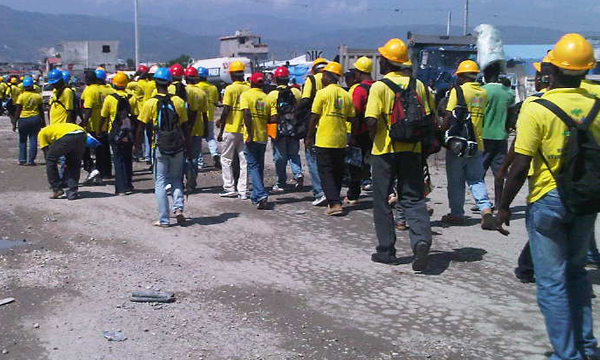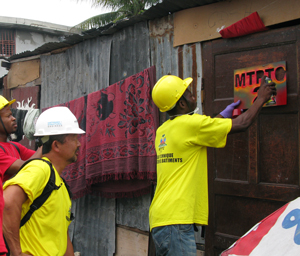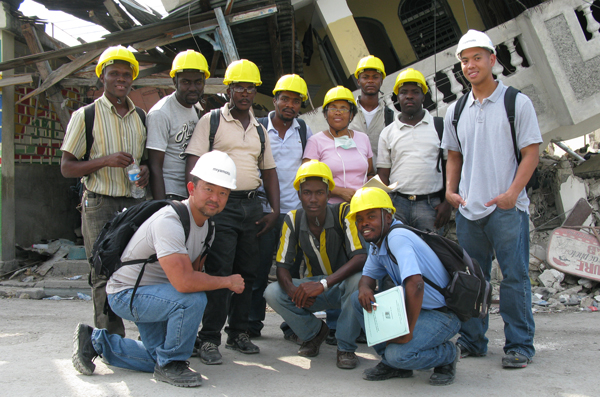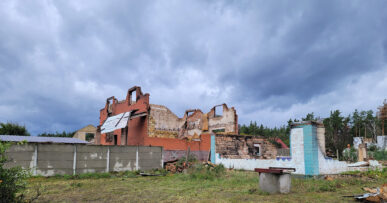- The 2010 Haiti Earthquake, Part 1
- The 2010 Haiti Earthquake, Part 2
- Miyamoto in Haiti: The Presidential Palace, A Fractured Haitian Icon
- Miyamoto in Haiti: Damage Assessment of the Japanese Embassy
- Miyamoto in Haiti: The Well-Oiled Relief Machine Rolling Through Haiti
- Miyamoto in Haiti: Inside a Heavily Damaged Building
- Miyamoto in Haiti: Visiting The Citadel
- Thirty Months in Haiti, Part 1
- Thirty Months in Haiti, Part 2
- Thirty Months in Haiti, Part 3
- Miyamoto in Haiti: A Morning and Afternoon of Hopeful Rebuilding
- Miyamoto in Haiti: School Rebuilding and Construction Continues
- Trente mois en Haïti, 1eme partie
- Trente mois en Haïti, 2eme partie
- Trente mois en Haïti, 3eme partie
- Miyamoto in Haiti: Visiting a Remote School Construction Site Near Cap-Haïtien
- Miyamoto in Haiti: Self-Sustaining Relief
- Miyamoto in Haiti: Love it or Hate it? Love it!
- Miyamoto in Haiti: Lycee de Cite Soleil Rehabilitation Project
- Miyamoto in Haiti: The Hopeful Road to Recovery
- A Day in the Haiti Disaster Zone
- Kidnappers & Disaster
- A Disaster Week in Haiti
Je viens juste de terminer mon discours prononçer à l’Hôtel Kinam de Port-au-Prince, Haïti. Le public m’a chaudement applaudi. Je me suis senti bien, chauffé a blanc. J’avais parlé devant plus de 100 participants, y compris le MTPTC (le Ministère des Travaux publics Transport et Communication Haïtien) des ingénieurs, des directeurs de ministères, des partenaires d’organisation non gouvernementale (ONG) et des médias. Cet événement devait en effet célébrer les réalisations des ingénieurs du MTPTC suite au tremblement de terre de 2010.
J’ai eu probablement plus de 50 allocutions a faire chaque année au cours de ces dernières années, a nombre de differentes audiences, et donner des discours etait devenu pour moi quelque peu routinier. Parfois, c’etait comme si j’executais une partition machinalement , mais pas cette fois. Ce fut un public des grands jours, et de vives émotions m’emparaient. J’avais travaillé en étroite collaboration avec ces personnes pendant les 30 derniers mois. Ils étaient devenu mes collègues, amis et étudiants. Ces jeunes ingénieurs haïtiens avaient travaillé dur pour sauver leur pays après cette catastrophe sans précédent. Bien qu’ils aient été totalement dépourvu, ces Haïtiens avaient intensifié leurs efforts et ont prouvé le contraire au monde qui les croyaient incapable de courage et de creativité pour realiser de grands projets.
J’avais rencontré ces 40 ingénieurs il y a 30 mois dans un abri provisoire que le MTPTC avait amenagé pour cette reunion. Le bâtiment official du ministère avait été detruit par le tremblement de terre. C’était en mars 2010. Nos projets étaient financés par l’UNFPA et la Banque mondiale pour développer et exécuter un programme afin d’évaluer les dégâts structurels globaux causés par cet tremblement de terre dévastatrice de magnitude 7.
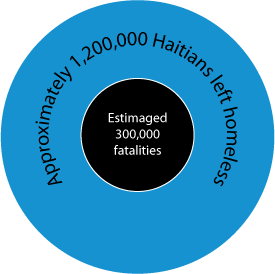 Le tremblement de terre en Haïti a tué environ 300,000 personnes et rendu plus de 1.2 millions sans abri. Notre mandat était simple: Il fallait bien comprendre ce qui était arrivé et du même coup crée une stratégie de reconstruction. Nous avons utilisé le Conseil Technologique Appliqué ATC-20 bien établie comme base pour créer un outil d’évaluation des dommages structurels automatisé. Cet outil d’évaluation utilise un GPS pour enregistrer les données et télécharger rapidement des informations tous les jours, de sorte que la situation pourrait être vu en temps réel. C’était la première fois dans l’histoire qu’un tel programme de haute technologie et de l’évaluation massif avait été élaboré. Nous avons sélectionné 260 meilleurs jeunes ingénieurs d’une liste du MTPTC contenant les récents diplômés d’universités. Tout d’abord j’ai procedé a la formation des formateurs et des gestionnaires. Ensuite, le reste du groupe a été formé dans une salle de classe par les formateurs du MTPTC conformement aux normes internationales etablies.
Le tremblement de terre en Haïti a tué environ 300,000 personnes et rendu plus de 1.2 millions sans abri. Notre mandat était simple: Il fallait bien comprendre ce qui était arrivé et du même coup crée une stratégie de reconstruction. Nous avons utilisé le Conseil Technologique Appliqué ATC-20 bien établie comme base pour créer un outil d’évaluation des dommages structurels automatisé. Cet outil d’évaluation utilise un GPS pour enregistrer les données et télécharger rapidement des informations tous les jours, de sorte que la situation pourrait être vu en temps réel. C’était la première fois dans l’histoire qu’un tel programme de haute technologie et de l’évaluation massif avait été élaboré. Nous avons sélectionné 260 meilleurs jeunes ingénieurs d’une liste du MTPTC contenant les récents diplômés d’universités. Tout d’abord j’ai procedé a la formation des formateurs et des gestionnaires. Ensuite, le reste du groupe a été formé dans une salle de classe par les formateurs du MTPTC conformement aux normes internationales etablies.
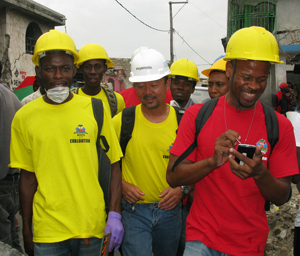 Mais la véritable formation a commencé sur le terrain Nous avons divisé les 260 ingénieurs en 17 divisions. Chaque division était dirigée par un ingénieur cadre du MTPTC déployé sur le terrain dans un fourgon, avec en main des assistants numériques personnels préprogrammés (PDAs). Douze ingénieurs de Miyamoto ont été répartis à travers les groupes pour fournir sur place la formation et le contrôle de la qualité. Finalement, la Fondation Pan-Américaine de Développement (PADF) et L’USAID OFDA (le Bureau Américain d’Aide au Désastre Étranger) est aussi devenue des partenaires dans le projet. Dan O’Neil de PADF est devenu un des plus grands partisans et supporter du programme de reconstruction.
Mais la véritable formation a commencé sur le terrain Nous avons divisé les 260 ingénieurs en 17 divisions. Chaque division était dirigée par un ingénieur cadre du MTPTC déployé sur le terrain dans un fourgon, avec en main des assistants numériques personnels préprogrammés (PDAs). Douze ingénieurs de Miyamoto ont été répartis à travers les groupes pour fournir sur place la formation et le contrôle de la qualité. Finalement, la Fondation Pan-Américaine de Développement (PADF) et L’USAID OFDA (le Bureau Américain d’Aide au Désastre Étranger) est aussi devenue des partenaires dans le projet. Dan O’Neil de PADF est devenu un des plus grands partisans et supporter du programme de reconstruction.
Au cours des 12 premiers mois, nous avons évalué 430 000 structures. Nous avons couvert toutes les zones touchées, de la jungle de béton densément peuplée de Port-au-Prince jusqu’aux champs verts de Léogâne. C’était incroyable. J’ai perdu 20 livres simplement a escalader les collines urbaines escarpées et bâtiments endommagés.
Les ingénieurs de l’équipe ont prouvés que les choses négatives qui ont été dites sur les Haïtiens n’etaient pas vraie. Les idées fausses repandues sur les Haïtiens a savoir qu’ils étaient paresseux et sans initiatives, et certaines personnes m’ont même affirme que tous les ingénieurs seraient absent lors de la Coupe du Monde de football ou les jours pluvieux. Devinez quoi? Ces idées étaient complètement fausses. Les Haitiens sont les gens les plus assidus et passionnés avec qui j’ai jamais travaillé. Ils se sont même presenté au travail le jour de la Noël et ont insisté a travailler sept jours par semaine. Seuls les ouragans et les manifestations politiques pendant les élections les ont arrêtés de le faire.
Nos efforts ont été récompensés. Nos ingénieurs du MTPTC ont été les premiers officiels a arriver sur les lieux ou les bâtiments s’ étaient effondrés pour évaluer les dégâts.
